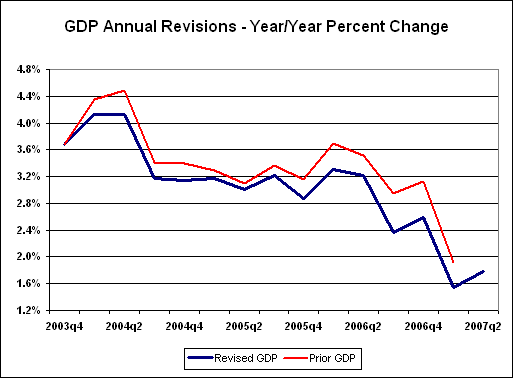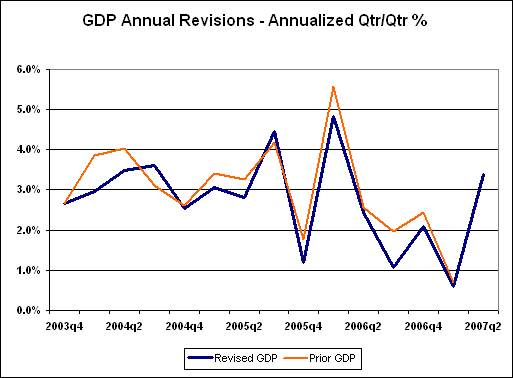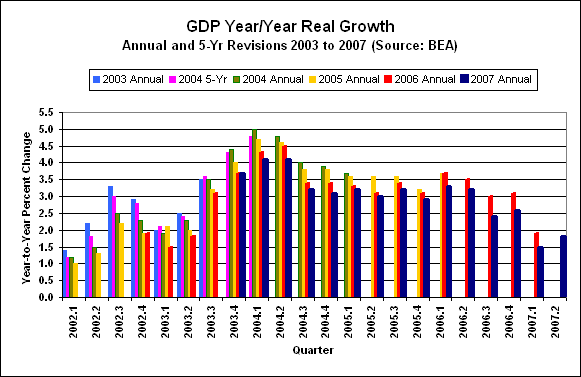Annual GDP Revisions and the SGS Alternate Measure
Reporting/Market Focus from the August 2007 Edition of the SGS Newsletter
Once again, and as estimated by SGS, annual GDP revisions have shown that previously reported GDP growth was overstated meaningfully. The current revisions out of the Bureau of Economic Analysis (BEA) reflect some of the downside benchmark revisions made to such series as retail sales, industrial production and housing. This continuing pattern of successive downward revisions over the years also tends to show some of the regular upside growth bias built into the GDP series.
Nonetheless, current and historical reported U.S. economic growth rates of recent years still remain heavily overstated, due largely to methodological "innovations" that have generated these and other upside biases in the official series. The Shadow Government Statistics Alternate GDP measure continues to approximate historical annual GDP with those biases removed (see the "Alternate Realities" section and Alternate Data Series tab at www.shadowstats.com for the latest plot and data, and the August 2006 SGS Newsletter for methodology). Given that the official 2007 annual revisions were in the normal scope of the previous SGS analysis, the SGS alternate growth estimates are unrevised.
The first set of graphs are as shown in the July 29th Alert. Prior GDP reporting is shown as the thin red lines, and the revisions, as well as the new "advance" second-quarter GDP estimate, as the thick blue lines. The first graph shows GDP growth on a year-to-year basis, the second graph shows it on an annualized quarterly basis.Annual GDP Revisions and the SGS Alternate Measure


The third graph shows the regular pattern of downward revision to GDP annual growth from initial reporting to the latest revision or estimate.

The successive annual GDP revisions are represented by the bars for each quarter, moving left to right in chronological order. With few exceptions, each revision has resulted in lowered growth than previously reported or previously revised.
The current annual revision only starts with first-quarter 2004. The revision patterns suggest downside surprises await the period of GDP growth during the now almost defunct 2000 recession. Those revisions have to wait for the five-year benchmark revisions, when the base inflation year is revised. At that time, all the accounts will be updated back to 1929. The next such revision is scheduled for 2009, when the base inflation adjustment year will be changed from 2000 to 2005. At that time, the 2000 recession should be recognized as having been much longer and deeper than previously reported. Full reporting of the current downturn may wait until 2014 or 2019, at which point newly reported quarterly contractions in 2006 and 2007 would be considered ancient history.
The "good" news out of the most revision is that the much-ballyhooed negative U.S. saving rate disappeared. While economic growth was revised lower, income generally, and quite questionably, was revised higher. Lower consumption and higher income lead to a higher saving rate. Such indeed would be good news if the series, which is the residual of two worthless series, was not meaningless itself, even in revision.
A final note, in terms of revisions that were not made: Included in that area are contentions in a recent Business Week article "The Real Cost of Offshoring" (June 18, 2007, page 29). I was asked by several subscribers to look at the analysis. Author Michael Mandel contended that inflation reported on U.S. imports of offshore products from Communist China, etc. was overstated and should be reduced. Since imports are subtracted from GDP, and lowering inflation inflates real growth, real GDP growth would be revised downward, perhaps significantly.
As best I can figure it, there is an offset in the BEA’s bookkeeping, double-entry and otherwise. A downward revision to import inflation, by itself, indeed would reduce reported real GDP growth. Yet, cheaper imported goods also would reduce the cost of those goods either in inventories or in personal consumption expenditure numbers, etc., which get added into GDP. Those changes largely would offset the effects of the cheaper imports. Aggregate real GDP growth would hold about the same, unchanged in net revision.